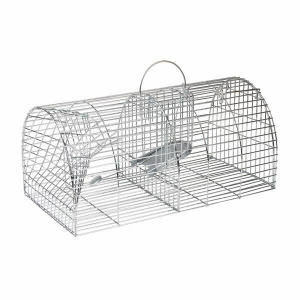
- Features of rodent control
- Types of traps for rats
- Destruction of rats with their own hands
Fighting rodents, especially with rats, is quite complex, and to some extent dangerous, so for the right result, you need to choose an effective weapon. An important role in this struggle is played by a trap for rats. Consider which traps for rats are most effective and whether you can make them yourself.
to content ↑Features of rodent control
Rats and mice can cause serious harm in a short period of time - not only to completely destroy food supplies, but also to spread infectious agents. With rats, there is a constant struggle on the storage of agricultural products, food stores, places of keeping pets.
Often used in this process are rat-catchers or traps. Such adaptations ensure environmental compatibility of the fight, as they do not have a negative impact on the environment. Most often, traps for rats are used in apartments, houses and in animal locations, that is, where chemicals can not be used.
 Despite the effectiveness of the use of traps, it is difficult to combat massively using this method, in this case other methods, including chemical ones, are used.
Despite the effectiveness of the use of traps, it is difficult to combat massively using this method, in this case other methods, including chemical ones, are used.
If you decide to use a mechanical rat-trap, then you will need different baits:
- Curd.
- Bakery products.
- Mixture of cereals.
- Cheese.
- Sausage.
- Smoked meat. Rice porridge.
Important! The bait for rats should be fresh and fragrantly smelling, as the spoiled products scare off the caudate "lodger".
What else should I consider when using traps?
- Place traps for rats in places of congestion of rodents, and best of all near mink. But first determine whether it is residential. To do this: lay the entrance to the burrow with grass or newsprint. If paper and grass are scattered in the morning, it means that the "lodger" is in place.
- Installing a trap with a bait is necessary against the rodent's movement course. Rats usually move mainly along the walls, trying to be unnoticed and avoiding the illuminated open area.
- Rodents avoid polluted terrain if you can find a clean path of movement. The animal, even entangled in the burdock, will not go any further until it is freed from the last thorn. Therefore, place traps for rats in unclimbed areas.
- Traps for catching rats should be perfectly clean. If the mechanism is dirty, then clean it with baking soda and do not forget to ventilate the device.
- It is necessary to carry out hunting for rodents gradually, accustoming them with the help of food on an inactive trail. It is noticed that only young rats fall into the traps, and adults, feeling danger, avoid them. In addition, the rodents have a highly developed visual memory - if they saw that the relative was trapped, then they will avoid it in the future.
- Use of traps in a residential area must be carried out following the safety precautions:
- Restrict children's access to the unit.
- You can not touch a dead rat without protection.
- In parallel with the use of krysovolkov it is necessary to prevent the control of rodents:
- To exclude the access of rats to food.
- Keep all rooms clean.
- Remove all sources of water so that thirst makes rats leave the room.
Types of traps for rats
A rodent trap can be purchased from a specialized store or manufactured by hand. It should be noted that rat-trappers and mousetraps differ only in size and power of the mechanism. All pest control devices can be divided into 2 types:
- Destroys the rodent.
- Leaves the animal alive, but isolated.
Ready-made traps for rats can be of the following types.
Mousetraps
 The simplest and inexpensive option. By activating the spring, the rodent is strongly clamped between two plates or the arc is pressed against the base of the device. Specialized tools can be made of both wood and metal. The upper part of the structure is made of metal.
The simplest and inexpensive option. By activating the spring, the rodent is strongly clamped between two plates or the arc is pressed against the base of the device. Specialized tools can be made of both wood and metal. The upper part of the structure is made of metal.
Important! The rat trap is usually completely metallic, and the device itself is more powerful.
Electric trap
Such a trap for a rat is a device in which rodents are destroyed by an electric discharge. It is presented in the form of a container with an isolated electrical discharge inside.
The device works only if it hits the inside of an animal trying to sneak a bait. The electric wings work either from an electrical network or from a battery of a certain type. The electric trap is effective and convenient to use, and also reliable in operation.
Pitfalls on the
principle The device has a wooden case with several holes. In the middle of the case, opposite the holes, a bait is laid, and at a distance from the beginning of the entrance to the bait a loop is arranged.
At a time when an animal is trying to steal a treat, the hook is triggered and the animals die from suffocation. Since the device has several holes, it is possible in this way to catch several pests.
Cells These designs are made of a wooden base and an upper metal frame. Inside the grid, a bait is attached to which the pest should react. As soon as he touches the treat, the trap closes.
Plastic house-traps
The house is a square pipe, on one side of which is a door, and on the other - a bait. The body of such a trap for rats is bent at an angle from the bait side. When open, the door rests on the floor. Getting to the bait, the rodent with its weight tilts the trap and the door closes tightly.
Container-cottages
Traps for rats of this species are designed to catch up to 15 rodents at a time. The construction of the device is made of plastic and is a rectangular container with several holes at the sides. A sturdy box has a removable tray, and bait is put into it.
Adhesive pad
The device is a surface covered with glue( sticky composition).The bait is placed on the platform. The rodent, rushing to the delicacy, gets on the pad and sticks to it.
to the contents ↑The destruction of rats with their own hands
We offer you several options, positively proven self-made krysovolokov.
Option number 1.A trap from a flower pot
You will need:
- Flower pot or other heavy container.
- Bait.
- "Storozhka" in the form of a piece of plastic or fiberboard.
Step-by-step manufacturing instructions:
- Prepare a piece of plastic in such a way that it has a flat part and a pointed end.
- Attach the bait to the end of the lodge.
- Turn the pot over and put it on the "lodge" with one edge, and on the floor with the other.
Function:

The rodent, penetrating inside, will try to pull off a piece of food. As a result of his actions, the "lodge" will move from the rib, and the pot will cover the rodent.
Important! For convenience, set the trap on the plywood. After the animal is captured, it will be easier to throw it away and the probability of undermining is reduced.
Option number 2.A bucket-bucket
- Prepare a bucket or other deep container.
- Fill the container with concentrated saline solution.
- Pour buckwheat, linseed or other husks( or sawdust) onto the surface of the liquid.
Important! The layer of husks should be quite thick and even.
- Place a few snacks on the husks.
- Place a ladder( a piece of wood) to the bucket.
Principle of action: the husk in the saline solution will not sink and cover the liquid. The rodent, hitting the top layer, will damage it and drown.
Option number 3.Trap from a plastic bottle
For homemade traps, prepare:
- Plastic bottle( 1.5 liters and more).
- Lesku.
- Bait( bread with droplets of unrefined sunflower oil).
- Scissors or knife.
Method of manufacture and use:
- With a plastic bottle, cut the neck so that the rodent can get inside.
- At the top of the bottle, cut a small hole.
- Tie a piece of twine or fishing line through the hole.
- Secure the second end of the string so that the trap hangs on it.
- Place the bait inside the device.
- Set the trap on the edge of the table.
Important! To prevent the bottle from slipping, place it on a piece of cloth.
- Find a suitable place for the installation of a mousetrap: the mouth of the container should be accessed by rodents, and the trap should hang freely on the string when tipping over.
Option number 4.Trap-cylinder
For the design can be used cans, plastic bottles or other cylindrical vessels. Use the trap-cylinder best in homes, sheds, so you can bury it in a deep and long ditch.
Principle of operation:
The rodent, getting inside, can not get out, because the cylinder walls are perfectly flat.
Option number 5.Cell
For the manufacture of cells by yourself you will need:
- Fine mesh
- Wire.
- 2 magnets.
- Pliers.
Manufacturing Method:
- Cut the sides of the future cell. All of them need 6. One of them will be used as a door.
Important! The easiest way is to make a square trap with equal sides.
- Fasten 5 sides with each other using wire to form a box.
- Attach the door on one side.
- At the contact point of the cage and the door, wire the magnets.
- Attach a piece of wire to the door, and slide its free end into the cage through the hinges.
- Place a heavy lure on the end of the wire inside the box. She will pull the door up and do not let it close.
Function:
When the pest removes food from the wire, the door closes and the magnet does not allow the rodent to open it.
We hope that you will be able to choose a reliable and acceptable trap for uninvited guests, do it yourself or buy in specialized stores.
You can experiment and use a win-win option - alabaster. This method has been known for more than a hundred years: mix flour and alabaster in equal proportions, place the remedy near the burrow of the rodent. Next, put a container of water to make the treat swell and pacify the stomach to the animal. What method and means to use choose yourself, if only it was safe for you and your loved ones. Have a good hunting!
